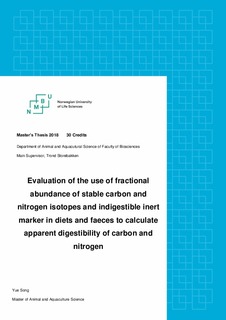| dc.description.abstract | The study carried out to test the feasibility of calculating apparent digestibilities (AD) of carbon and nitrogen with diets in fishmeal (FM), soybean meal (SBM), and rapeseed meal (RSM) as the main sources of protein by calculating the fractional abundance of stable carbon and nitrogen isotopes (13C and15N) in diets to relative faeces with yttrium oxides ratios. In order to evaluate the potential of applying a fractional abundance of stable isotopes to test AD, the results of this study were taken to compare with AD estimated by quantifying total carbon and nitrogen in the previous study of (Shomorin 2017). Three different extruded diets, FM, SBM, and RSM used in this study, were fed to the triplicate groups of 120-g rainbow trout (Oncorhynchus mykiss) for once a day. The rearing temperature of freshwater was kept around 14 degrees constantly during the 22 days of this experiment. Two different faeces collection methods, stripping and sieving from retch wire screen (at 15 min and 240min, respectively) were utilized in this experiment. Dried freeze experimental diets and relative faeces were sampled around 0.15 mg in small plastic containers and then sent to the Institute for Energy Technology in Kjeller, Norway for stable isotope analysis.
Similar carbon isotope signatures were obtained by stable isotope analysis on FM, SBM and RSM, which were -22.57, -23.87 and -24.22, respectively. A significant differences were observed for the nitrogen isotope signatures among FM and rest of diets (SBM and RSM), which were 7.59, 3.56 and 4.22, respectively. This may be due to the more balanced amino acid profile in FM, compared with C3 based plant protein (e.g., SBM and RSM). The stable isotope analysis on faeces collected by stripping illustrates fecal carbon isotopes was enriched relative to FM and SBM while depleted relative to RSM. On the other hand, nitrogen isotope signatures in faeces collected by stripping were depleted towards FM, SBM, and RSM. The ANOVA analysis showed the significant (<0.05) difference for the fecal carbon and nitrogen isotopes signatures with the increasing exposure time of faeces in water. The stable carbon isotope signatures in faeces originated from FM, SBM and RSM were all decreasing as the prolongation of exposure of faeces in water. This is an indication of fecal 13C loss by nutrient leaching. However, a significant increase was found for the fecal stable nitrogen isotopes derived RSM during the first 15 min faeces collection intervals, and then decrease was observed from 15min to 240 min faeces collection intervals. Furthermore, the same pattern being directly from the stable isotope signatures was observed in the fractional abundance of stable isotopes in diets and faeces.
Apparent digestibilities estimated based on the fractional abundance of stable carbon and nitrogen isotopes in diets to faeces were not significantly different from that estimated by using total carbon and nitrogen for both faeces collection methods (stripping and retch wire screening). But the AD estimated by the fractional abundance of stable isotopes was generally higher than total elements among diets. This indicates that applying fractional abundance of stable isotopes to calculate AD is more quantitative, compared to using total elements. The AD estimated based on the fractional abundance of stable carbon isotopes ranked the digestibility of 3 experimental diets in this order (FM >SBM> RSM), and (SBM >FM> RSM) was observed when AD estimated based on the fractional abundance of stable nitrogen isotopes. The ranking trend observed in this study was in a line with the AD estimated based on corresponding total elements in the previous experiment of (Shomorin 2017).
Moreover, AD estimated by the fractional abundance of carbon and nitrogen isotopes obtained by collecting faeces on retch wire screen is higher than obtained by stripping methods, except for AD of 13C observed for FM. This corresponds to the observation done by (Shomorin 2017) when the estimates were made based on total C in feeds and excreta. | nb_NO |

